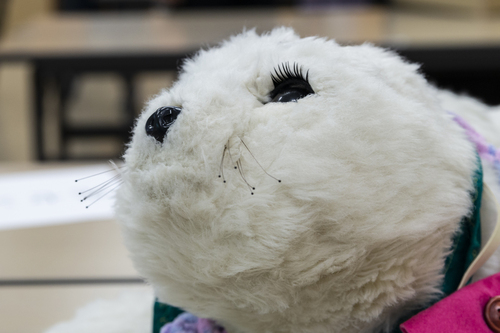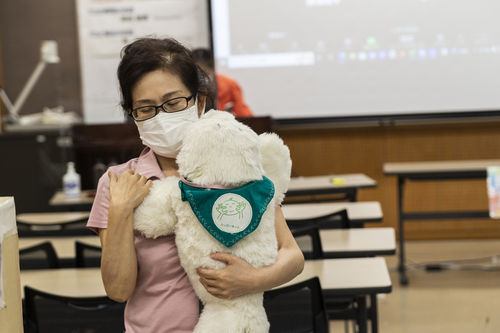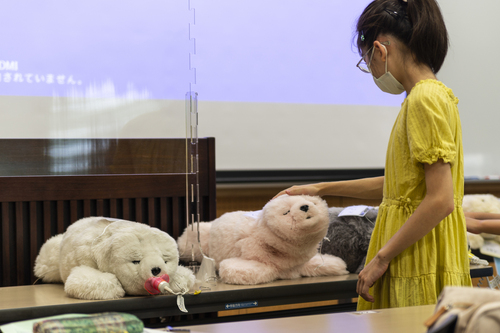If you have visited Nagoya University Museum, you have probably met Paro, the seal-shaped therapy robot developed by Japanese researchers. Paro is a celebrity, having featured in The Simpsons and even met President Barack Obama. With their soft fur, big eyes, and chirping cries, there is no doubt that Paro robots are cute, but beyond that they are also highly versatile and effective in several settings and applications.
Dr Takanori Shibata, Chief Senior Research Scientist at the National Institute of Advance Industrial Science and Technology, is Paro's designer. He visited Nagoya University Museum in August 2022 to discuss Paro's unique charm and abilities that led it to be declared the world's most effective therapy robot by Guinness World Records in 2003.
The Paro concept is based on animal therapy, which has several positive physiological, psychological, and social therapeutic effects. Animal therapy, however, has disadvantages that make it difficult to implement widely. Some people are allergic to animals.Some animals carry diseases, making interaction with immunocompromised patients impossible. Some creatures are unpredictable and can accidentally scare or harm patients.
Paro, on the other hand, is hypoallergenic and safe. It can sit unobtrusively in places where animals may be considered a nuisance. It does not get ill or die. It does not need to be looked after if the guardian is at work or on vacation.
Paro's appearance is based on the baby harp seal. Why a seal, and not a familiar pet such as a dog or cat? "Animals with which humans have less contact are better accepted as robots because we are not familiar with how they behave naturally," explained Shibata. "If you try to make a robot in the shape of a cat, for example, people will be disappointed, since it's impossible to make its movements appear natural."
The baby seal offered a cute canvas on which it was easy to apply the technology. Paro's movements appear relatively simple but are controlled by a complex set of sensors that allow the robot to react naturally to several inputs. Turn Paro upside down, and it will flap its flippers angrily and cry out until you right it. Scratch its head and it closes its eyes in pleasure. Touch its whiskers too harshly and it shies away and chirps in annoyance. If you pick Paro up and snuggle it, it will rest its head on your shoulder.
Making Paro feel like a natural companion and avoiding the feeling of it being an electronic device that must be switched on and off as you use it was an important part of its development. Left alone, Paro will rest its head down and go to sleep, opening its eyes, and waking up again when you return, turning its head in the direction from which you approach it. Turn the TV on and Paro's sensors will detect it, turning its head to sit and watch with you.
Spending time with Paro is a lot of fun. But what therapeutic effect does it have for people who need it? Research and clinical experience indicate that robot animal therapy has a calming effect on patients who struggle with dementia or developmental disabilities. The calming experience of interacting with Paro can prevent these patients needing to be medically sedated, improving their lives and the environment in the facilities in which they live. The tests in the patients showed that their stress levels decreased, and depression symptoms improved. Support staff reported lower levels of work-related stress and greater opportunity to communicate and share positive experiences with patients that were facilitated by Paro's presence.
Paro has also been successfully used in treatment of people with PTSD, autism, Down syndrome, and children undergoing chemotherapy. After the 2011 Fukushima earthquake, Paro robots were used to treat children living in evacuation shelters. Recently, the little robot has been giving therapy to children displaced by the war in Ukraine. Although Paro has worked in over 30 countries, its next mission may be even further afield. It is currently being considered as a stressbusting and consequently safety-boosting companion to astronauts on a manned mission to Mars.
Almost 20 years after it first entered the record books, Paro's record as the most effective therapy robot remains standing. More than 7,000 have been made. You can meet a few of them at the Nagoya University Museum.
The Nagoya University Museum, which houses a variety of permanent and temporary exhibitions, is open to the public between 10:00 and 16:00, Tuesday to Saturday.



